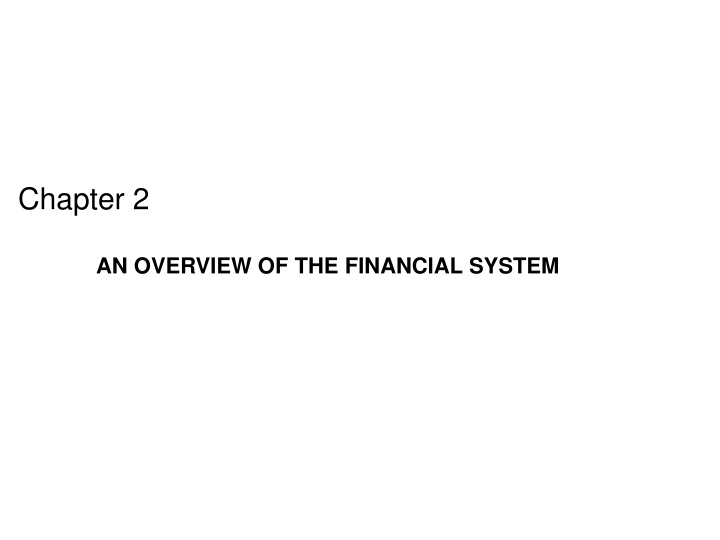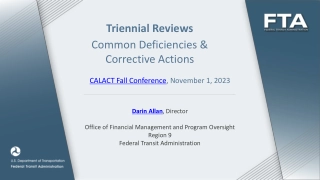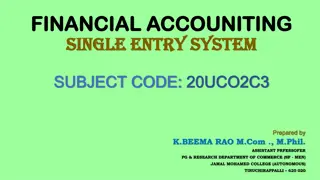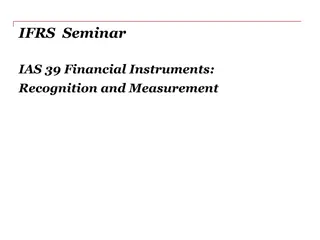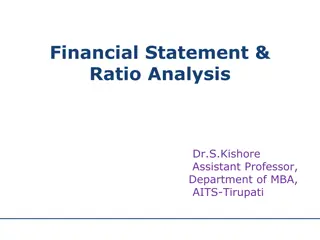Overview of Financial System
This overview of the financial system covers topics such as direct and indirect finance, financial markets, types of financial instruments, international dimensions, and the roles of financial intermediaries and regulations. It also delves into the functions and structures of financial markets, as well as the flows of funds through the system. Explore the different components and operations within the financial sector to gain a comprehensive understanding of its functions and impact on the economy.
Download Presentation

Please find below an Image/Link to download the presentation.
The content on the website is provided AS IS for your information and personal use only. It may not be sold, licensed, or shared on other websites without obtaining consent from the author.If you encounter any issues during the download, it is possible that the publisher has removed the file from their server.
You are allowed to download the files provided on this website for personal or commercial use, subject to the condition that they are used lawfully. All files are the property of their respective owners.
The content on the website is provided AS IS for your information and personal use only. It may not be sold, licensed, or shared on other websites without obtaining consent from the author.
E N D
Presentation Transcript
Chapter 2 AN OVERVIEW OF THE FINANCIAL SYSTEM
Learning Objectives (1 of 2) Compare and contrast direct and indirect finance. Identify the structure and components of financial markets. List and describe the different types of financial market instruments. Recognize the international dimensions of financial markets.
Learning Objectives (2 of 2) Summarize the roles of transaction costs, risk sharing, and information costs as they relate to financial intermediaries. List and describe the different types of financial intermediaries. Identify the reasons for and list the types of financial market regulations.
Function of Financial Markets (1 of 2) Performs the essential function of channeling funds from economic players that have saved surplus funds to those that have a shortage of funds Direct finance: borrowers borrow funds directly from lenders in financial markets by selling them securities
Function of Financial Markets (2 of 2) Promotes economic efficiency by producing an efficient allocation of capital, which increases production Directly improve the well-being of consumers by allowing them to time purchases better
Figure 1 Flows of Funds Through the Financial System
Structure of Financial Markets (1 of 3) Debt and Equity Markets Debt instruments (contractual agreement) Maturity: the remaining time until the expiration date Equities (claims to net income and assets) Dividends: periodic payment to shareholders Residual claimant
Structure of Financial Markets (2 of 3) Primary and Secondary Markets The primary markets are not well known to the public. Investment banks underwrite securities in primary markets. The previously issued securities will be sold in the secondary market Brokers and dealers work in secondary markets.
Structure of Financial Markets (3 of 3) Exchanges and Over-the-Counter (OTC) Markets: Exchanges: NYSE, Chicago Board of Trade OTC markets: Foreign exchange, Federal funds Money and Capital Markets: Money markets deal in short-term debt instruments Short terms to maturity, least price fluctuations and least risky investment Capital markets deal in longer-term debt and equity instruments With maturities more than one year
Financial Market Instruments (1 of 2) Table 1 Principal Money Market Instruments Amount ($ billions, end of year) 1990 2000 527 647 547 1,053 Type of Instrument U.S. Treasury bills Negotiable bank certificates of deposit (large denominations) Commercial paper Federal funds and security repurchase agreements 2010 1,767 1,923 2016 1,816 1,727 558 372 1,602 1,197 1,058 3,598 885 3,778 Source: Federal Reserve Flow of Funds Accounts; http://www.federalreserve.gov
Money Market Instruments Treasury Bills No interest payments but they are sold at a discounted price The most liquid instruments Negotiable Bank Certificates of Deposits Commercial Papers Repurchase Agreements With very short maturities Treasury bills serve as collateral (an asset that the lender will receive if the borrower defaults)
Financial Market Instruments (2 of 2) Table 2 Principal Capital Market Instruments Amount ($ billions, end of year) 1990 2000 3,530 17,628 2,676 5,205 1,703 4,991 2,340 3,171 Type of Instrument Corporate stocks (market value) Residential mortgages Corporate bonds U.S. government securities (marketable long-term) U.S. government agency securities State and local government bonds Bank commercial loans Consumer loans Commercial and farm mortgages 2010 23,567 10,446 10,337 7,405 2016 38,685 10,283 12,008 12,064 1,446 957 818 811 838 4,345 1,139 1,497 1,728 1,276 7,598 2,961 2,001 2,647 2,450 8,531 3,030 3,360 3,765 2,850 Source: Federal Reserve Flow of Funds Accounts; http://www.federalreserve.gov
Internationalization of Financial Markets Foreign Bonds: sold in a foreign country and denominated in that country s currency Eurobond: bond denominated in a currency other than that of the country in which it is sold Eurocurrencies: foreign currencies deposited in banks outside the home country Eurodollars: U.S. dollars deposited in foreign banks outside the United States or in foreign branches of U.S. banks World Stock Markets: help finance corporations in the United States and the U.S. federal government
Function of Financial Intermediaries: Indirect Finance (1 of 3) Lower transaction costs (time and money spent in carrying out financial transactions) Economies of scale Liquidity services Reduce the exposure of investors to risk Risk sharing (asset transformation) Diversification
Function of Financial Intermediaries: Indirect Finance (2 of 3) Deal with asymmetric information problems: Adverse Selection (before the transaction): try to avoid selecting the risky borrower by gathering information about them Moral Hazard (after the transaction): ensure borrower will not engage in activities that will prevent him/her to repay the loan. Sign a contract with restrictive covenants.
Function of Financial Intermediaries: Indirect Finance (3 of 3) Conclusion: Financial intermediaries allow small savers and borrowers to benefit from the existence of financial markets.
Types of Financial Intermediaries (1 of 3) Table 3 Primary Assets and Liabilities of Financial Intermediaries Primary Liabilities (Sources of Funds) Blank Type of Intermediary Depository institutions (banks) Primary Assets (Uses of Funds) Blank Commercial banks Deposits Business and consumer loans, mortgages, U.S. government securities, and municipal bonds Savings and loan associations Deposits Mortgages Mutual savings banks Deposits Mortgages Credit unions Deposits Consumer loans
Types of Financial Intermediaries (2 of 3) [Table 3 Continued] Primary Liabilities (Sources of Funds) Blank Type of Intermediary Contractual savings institutions Life insurance companies Primary Assets (Uses of Funds) Blank Premiums from policies Corporate bonds and mortgages Fire and casualty insurance companies Premiums from policies Municipal bonds, corporate bonds and stock, and U.S. government securities Pension funds, government retirement funds Employer and employee contributions Corporate bonds and stock
Types of Financial Intermediaries (3 of 3) [Table 3 Continued] Primary Liabilities (Sources of Funds) Blank Type of Intermediary Investment intermediaries Primary Assets (Uses of Funds) Blank Finance companies Commercial paper, stocks, bonds Consumer and business loans Mutual funds Shares Stocks, bonds Money market mutual funds Shares Money market instruments Hedge funds Partnership participation Stocks, bonds, loans, foreign currencies, and many other assets
